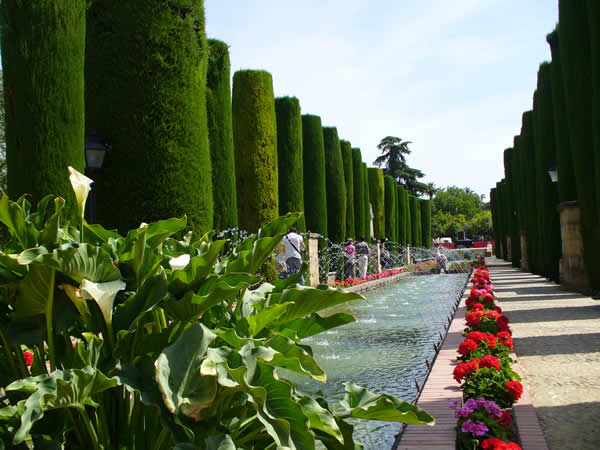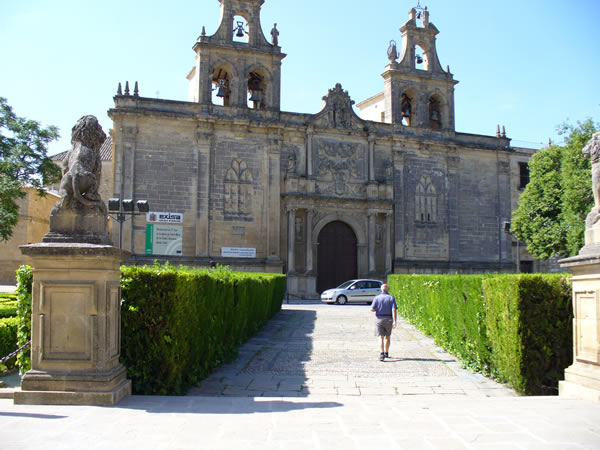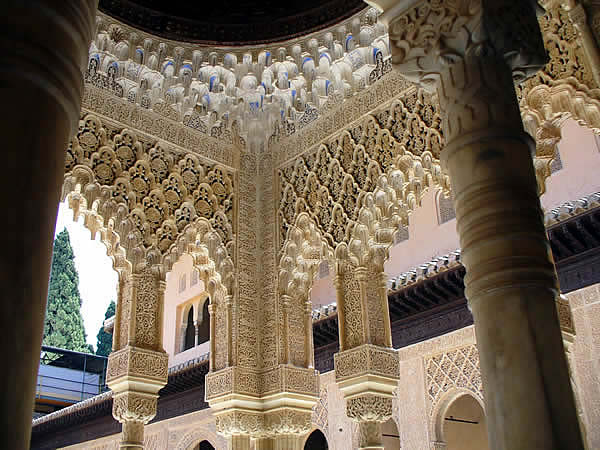This post is also available in:
![]() Deutsch
Deutsch
This year we had two weeks of holidays and we decided to prepare a customized itinerary to visit the most beautiful destinations in Andalusia. In this itinerary in Andalusia we decided to visit the three most important cities in the region, namely Seville, Granada and Cordoba. But together with these beautiful cities we also wanted to see some small but very pretty villages of Andalusia such as Baeza and Ubeda, rich in Renaissance buildings, or like Ronda, Vejer de la Frontera and Arcos de la Frontera in the Pueblos Blancos area of Andalusia. Here is our itinerary in Andalusia:
1 day, SEVILLE
Our itinerary in Andalusia begins with boarding by plane for Seville. We arrive at Seville airport. We collect our rental car.
Since our flight arrived in the late evening, we preferred to stay overnight in a hotel near Seville airport.
Overnight in Seville: Hotel Catalonia Hispalis, Sevilla: We chose it because it is located near Seville airport.
Day 2, SEVILLE-CARMONA-ECIJA-CORDOBA 150 km
We leave early in the morning and take the E5 road to Cordoba. We stop along the way to visit the towns of Carmona (38 km) (Carmona, a small village with a tower of the fifteenth century in imitation of the Giralda of Seville) and Ecija (92 km) (Ecija, known for its baroque bell towers ).
Overnight in CORDOBA: Hotel Eurostars Maimonides, Córdoba: An excellent three-star hotel, located in the city center a few steps from the Mesquita of Cordoba. Very importantly, the hotel has a guarded parking lot at a reasonable price, excellent value price. We had a great time.
3 day, CORDOBA
Full day dedicated to visiting Cordoba. The visit of the city starts from the wonderful Mezquita (mosque), the most interesting building in Cordoba. The entrance is located where is the Patio de los Naranjos, an Arab courtyard for ablutions furnished with orange trees and fountains, at the time of the Arabs all the 19 naves of the mosque were open towards this courtyard, forming an evocative scenographic effect.
After the Christian conquest, chapels were built, which undermined this effect: the Capilla Villaviciosa with surprising arches, and the Capilla Real in the Mudejar style which became the pantheon of Spanish rulers. In 1523 the construction of the Cathedral began inside the mosque, completed in 1599, forming the extraordinary architectural union of church-mosque that we can admire today.
Overnight CORDOBA: Hotel Eurostars Maimonides, Córdoba

4 day, CORDOBA
Today we visit the defensive structures of the Alcázar de los Reyes Cristianos (1328), the Torre Fortaleza de la Calahorra, the ancient Roman bridge, the great Arab mills, the ancient Jewish synagogue, the Caliph Baths, the typical streets and squares of the medieval Jewish quarter called Judería. In the plaza de la Corredera are the remains of a Roman temple, the Renaissance Ayuntamiento and nearby the Romanesque church of San Pablo.
An excursion not to be missed 7 kilometers from Córdoba, along the N-437 road, is the ruined city of Medina Az-Zahra, a pleasure city built in the 10th century by Abd al-Rahman III and completed by Almansur, another splendid testimony of the Arab domination in Cordoba.
Overnight in CORDOBA: Hotel Eurostars Maimonides, Córdoba
5 day, CORDOBA-JAEN- BAEZA 153 km
Continue our itinerary in Andalusia. We take the road that leads to Jaen. Visit of Jaen (105 km). To visit: the Catedral de Jaén, the Castillo de Santa Catalina, the Palacio de Villardompardo with the Baños Árabes. Then we arrive in Baeza. We visit Baeza in the afternoon (where we sleep for 2 nights) and the next day we visit Ubeda.
Baeza: The visit of the city begins from the plaza del Populo, also known as plaza de los Leones, which overlook the sixteenth-century Casa del Populo, the Fuente de Los Leones and the Carniceria (an old butcher shop). Just beyond is the Cathedral of Santa María, a Gothic-Renaissance work by Andrés de Vandelvira. Other buildings to visit are: the University, founded in 1538, the Palacio de Jabalquinto, the Ayuntamiento and some buildings in the squares of the Plaza de España and the Paseo de la Constitucíon. The gates of Ubeda and Cordoba and the arch of Baeza are among the few remains of the Arab fortifications visible today.
Overnight in BAEZA: Hotel La Casona Del Arco, Baeza: An excellent three-star hotel, located in the center of Baeza, welcoming and well-kept environment. Really nice, maybe it deserves even one more star than it has. We had a great time.

Day 6, BAEZA-UBEDA-BAEZA 20 km
Full day dedicated to visiting Ubeda: the Renaissance heart of the city is the Vázquez de Molina plaza, one of the best Renaissance spaces in Spain. In the square there are the Sacra Capilla del Salvador, the Gothic Iglesia de Santa María de los Reales Alcázares, the Palacio de Vázquez de Molina, the Antiguo Pósito (17th century grain store), the house of Juan de Medina, the Cárcel del Obispo, the Palacio del Deán Ortega, the Palacio del Marqués de Mancera, and the Palacio Francisco de los Cobos.
Other interesting monuments of Úbeda are: the Hospital de los Honrados Viejos del Salvador, the Hospital de Santiago, in the Mercado square, there are some interesting buildings such as the iglesia de San Pablo (XV-XVI century), and the Ayuntamiento Viejo.
Overnight in BAEZA: Hotel La Casona Del Arco, Baeza
7 day, BAEZA-GUADIX-GRANADA 181 km
We leave and in the morning we visit the town of Guadix (to reach it you have to take the road from Baeza to Ubeda, Jodar, Torre Credela, Guadix) where you can visit the Cathedral, built on the site of the largest mosque of the Muslim community starting from 1510 is in Gothic-Renaissance style. It was finished in the 18th century with the Baroque facade, the tower is from the 17th century. In the sacristy there is an interesting Museo Catedralicio with Baroque paintings, manuscripts and goldsmiths.
The Alcazaba the Arab fortress built in the tenth century which was the last Arab bulwark to Christian conquest and dominates the city from above. The church of Santiago from 1540 with a rich Plateresque portal, and the Barrio Troglodita, the neighborhood of the famous characteristic houses carved out of the tuff, the natural viewpoints of Cuatro Veredas and San Fandila offer a spectacular view of the neighborhood.
We continue our itinerary in Andalusia arriving in Granada.
Overnight in GRANADA: Best Western Dauro II, Granada: Three star hotel in the center of Granada, near the cathedral. The hotel has parking (a short distance away) at a reasonable price, good value for money. We enjoyed it.
8 day, GRANADA
Today is dedicated to visiting the Alhambra (Alcazaba, Palas Nasridi and Generalife). The visit must be booked in advance on the website: www.alhambratickets.com. Tickets are collected at the Alhambra Patronage ticket office on the same day of the visit, and the ticket identification number must be presented, together with an identity document or passport.
Remember that the important thing is to respect the time for which you have booked access to the Nasrid Palaces, in fact you have 30 minutes to enter, so you must be punctual.
The Alhambra, the medieval Arab royal citadel overlooking the city is recognized as one of the jewels of world architecture. It is a series of palaces and gardens built in the 14th century during the Nasrid dynasty. The visit to this immense complex has its strengths in the Sala de los Embajadores, in the Patio de los Leones and in the Sala de las Dos Hermanas. Of the subsequent buildings of the Christian era, the Palacio de Carlos V is interesting, where today the Museo de Arte Hispano-Musulman and the Museo de Bellas Artes (Spanish paintings) are housed.
The Generalife, the fourteenth-century country residence of the emirs is located just below the walls of the Alcazar. Here there are beautiful gardens, some hanging, fountains and you can admire beautiful views of the Sierra Nevada and the city.
Overnight in GRANADA: Best Western Dauro II, Granada

9 day, GRANADA
Another day dedicated to visiting Granada. To visit the huge Gothic Cathedral built, in place of the Mezquita Mayor, between 1523 and 1703, with the Capilla Mayor and the Capilla Real where the tombs of Isabella and Ferdinando are sculpted by the Tuscan Domenico Fancelli. Among the churches, the churches of Santa Ana (in Mudejar style, 1537-1563), San Salvador (in Mudejar style, 16th century), Santo Domingo (1532), San José and San Jeronimo (1496-1547) are worth visiting.
On the hill in front of the Alhambra there is the Albaicin, the old Arab casbah or “medina”. At the highest point of the hill is the Plaza de San Nicolas from where you have a wonderful view over the citadel of the Alhambra. Granada still houses the most complete group of houses and palaces with Arab architecture in Europe. Among which the Dar al Horra, or the Alcazar Genil, or houses such as the Horno de Oro house, the Chapiz house, or the Abén Humeya house, the public baths such as El Bañuelo or the Alhambra baths, and the complex of Arab public fountains and wells (aljibes).
To the north of the city is the Sacromonte hill, with cave dwellings. Just outside the city, on a hill, is the baroque Cartuja Monastery.
Overnight in GRANADA: Best Western Dauro II, Granada

10 day, GRANADA-ANTEQUERA-RONDA 176 km
Departure from Granada for Ronda, in the morning, along the route stop in Antequera (88 km) and if possible a short detour to visit the natural park of El Torcal characteristic for its beautiful rock formations.
Antequera: to visit the Dolmens, which are located in the park west of the town, the most spectacular of which is the Cueva de la Menga, dating back to 5000 years ago. Other buildings not to be missed are the Roman Baths, the Giants’ Arch, the 13th century Arab Castle (Alcazaba), the magnificent Renaissance collegiate church of Santa María la Mayor (16th century), and the church of Nuestra Señora del Carmen. The 18th century palacio de la Nájera is home to the Municipal Museum, the highlight of the museum is the Efebo of Antequera. In the vicinity of Antequera, the following must be visited: the El Torcal natural park, characteristic for its beautiful rock formations; and the Fuente de Piedra lagoon where flamingos nest.
In the early afternoon we continue our itinerary in Andalusia and arrive in Ronda.

THE SPLENDID CITY OF RONDA
Ronda: A beautiful town with remarkable buildings from the Arab period: the Mandragon palace, the Arab baths (Baños Arabes), the palace of the Moro king (Casa del Rey Moro) and the walls that surround part of the city. From the Christian period are: the Iglesia de Padre Jesús, the Iglesia de Santa María, the Convento de San Francisco, the Iglesia Convento de la Merced, the Iglesia del Espíritu Santo and the Palacio del Marqués de Salvatierra.
The eighteenth century will have a greater impact on the urban aspect of Ronda. In this century the most significant monuments will be built, such as the New Bridge, the Arco de Felipe V, the Templete de la Virgen de los Dolores, the Casa Consistorial and the Plaza de Toros (1785). Do not miss, near the Plaza de Toros, the beautiful promenade, called Alameda del Tajo, which offers magnificent panoramic views of the Ronda mountains.
Overnight in RONDA: Husa Reina Victoria, Ronda: A beautiful four star hotel near the center with beautiful views over the town. We wish we could have stayed a few more days and not a single night.

11 day, RONDA-GIBRALTAR-TARIFA-VEJER DE LA FRONTERA-CONIL DE LA FRONTERA 187 km (215 km with the detour to Gibraltar)
The itinerary in Andalusia continues following the road that passes through Jimena de la Frontera, Castellar de la Frontera, until reaching the crossroads for Gibraltar. Here, if you want, you can cross the border and enter Gibraltar. Where you can visit the Rock from which you can enjoy a spectacular view of the strait on one side and Morocco which is a handful of kilometers away.
The upper part of the fortress is home to a splendid natural reserve where over 600 species of plants live. Gibraltar is then inhabited by the famous Barbary macaques, the only primate species that lives in Europe in the wild.
We then continue to Tarifa, up to Punta Marroqui, the southernmost point of mainland Spain: Africa is just a few kilometers away! Then we visit the remains of the Roman city of Baelo Claudia located in an enviable position in the Ensenada de Bolonia, a spectacular beach.
We go up the coast to Vejer de la Frontera, a characteristic Andalusian town that we will visit and then to Conil de la Frontera where we will sleep.
Overnight in CONIL DE LA FRONTERA: Hotel Diufain, Conil de la Frontera: An excellent three star hotel, in Andalusian style, located in a quiet place with free parking.

12 day, CONIL DE LA FRONTERA-ARCOS DE LA FRONTERA-SEVILLE 182 km
At this point during of our itinerary in Andalusia we recommend a detour to Arcos de La Frontera (77 km). It is a city considered among the most beautiful in Spain both for its position (on a cliff) and for the monuments and the characteristic urban layout. It is also possible to visit the city of Cadiz (Baroque-style Vieja Cathedral, beautiful city wall of about 5 km, Castillo de Santa Catalina).
We then reach Seville in the afternoon. Our itinerary in Andalusia by car has ended. We bring the car back to the rental and take a taxi to the hotel. However, we have to see the beautiful city of Seville.
Overnight in SEVILLE: Hotel America Sevilla: A three star hotel, located in an excellent position in the city center just a few minutes walk from the cathedral, good welcome from the staff. Good value for money.
13 day, SEVILLE
Day dedicated to the visit of Seville, whose three most important monuments are: the Cathedral, the Alcázar and the Archivo General de Indias. These monuments have been declared by UNESCO a world heritage site.
The Alcázar, is an architectural jewel of the Arab era (IX century). The interior is ordered around two courtyards, the courtyard of Las Doncellas and that of Las Muñecas. The ambassador’s room, decorated in Mudejar style, is among the most beautiful rooms. In front of the Alcázar is the Cathedral, built above the Mosque, of which the magnificent Giralda minaret remains, one of the symbols of Seville. The Cathedral houses examples of structures from the Arab period, such as the courtyard called Las Abluciones and the Del Perdón gate. The interior, with five naves, is immense, inside there are the remains of Christopher Columbus.
The Torre de Oro, an octagonal tower built in the 13th century near the river to defend the city, now houses the Maritime Museum. Of significant cultural and historical importance is the Archivo General de Indias, which houses millions of original and unique documents on the Spanish colonies in America and in the rest of the world.
OTHER INTERESTING PLACES TO SEE IN SEVILLE
Among the districts of Seville worth mentioning in the Triana district: the convent de las Minimas (1755), the church of San Giacinto (1775) and the remains of the castle of San Giorgio seat of the Inquisition. Another interesting neighborhood is that of Santa Cruz. Originally the Jewish quarter, the Judería of Seville here are located: the Palacio de las Dueñas, the Casa de Pilatos, and the Alameda de Hércules, one of the historical walks of the city. The Plaza de Toros de la Real Maestranza de Caballería de Sevilla is the oldest bullfighting arena in Spain.
The modern architecture of Seville is also interesting: Expo 92 with the theme park of the Magic Island and the monumental Alamillo bridge by the architect Santiago Calatrava. The Plaza de España, is the monument that remains of the 1929 exhibition.
Overnight in SEVILLE: Hotel America Sevilla
14 day, SEVILLE
Among the places to visit around Seville: the remains of the ancient city of Italica, birthplace of the Roman emperors Trajan and Hadrian. The town of Alcalá de Guadaira with imposing Arab fortification works. Not far from Seville there is another site declared a UNESCO World Heritage Site in 1984, the Parque Nacional de Doñana. The area is important for its biodiversity, there are stretches of lagoons, swamps and dunes; during the winter the place is frequented by over 500,000 water birds.
Overnight in SEVILLE: Hotel America Sevilla
Day 15, SEVILLE-FLIGHT TO HOME
Here ends our itinerary in Andalusia. Return flight. Remember that you must be at the airport at least 2 hours before the departure time.
This post is also available in:
![]() Deutsch
Deutsch
 Travel Guide Travel Guide to the countries of the world
Travel Guide Travel Guide to the countries of the world










